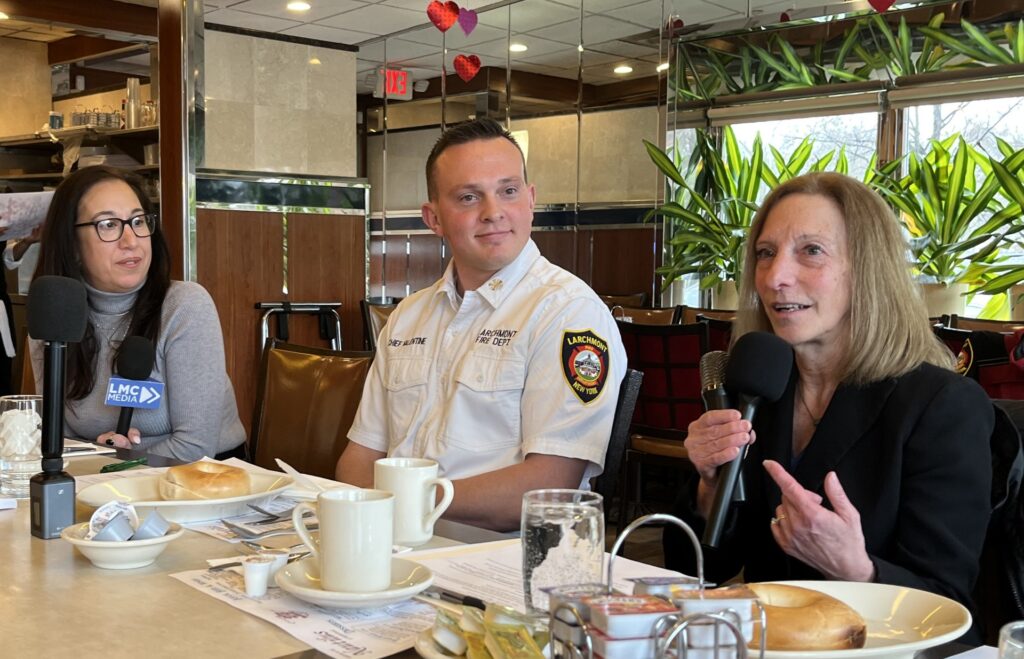
left to right: Gloria Golle (Local Summit board member and moderator), Chief Richard Valentine, and Commissioner Susan Spear.
Strategies for Protecting Your Home and Family from Disaster
By Linnet Tse
Catastrophes such as fires, floods and extreme cold can strike quickly and without warning. At the Larchmont-Mamaroneck Local Summit’s timely program on February 11, Susan Spear, newly appointed Commissioner of the Westchester County Department of Emergency Services (“Commissioner”), and Richard Valentine, Chief of the Village of Larchmont Fire Department (“Chief”), led a spirited discussion on emergency preparedness and provided valuable advice on how to protect our home and family from disaster. A recurring theme throughout the discussion was the importance of education and preparedness.
What’s the County’s Role?
While a municipality’s fire, police and EMS units respond directly to a local emergency, the County plays a huge, often behind-the-scenes role to keep residents safe. Highlighting just a few of her department’s many responsibilities, the Commissioner explained that the Emergency Services Department provides training and education, both to fire/EMS units across the county as well as to the public; it also provides dispatch services for the 52 fire departments and 32 EMS agencies in the County as well as hazmat and technical rescue services.
Importance of Collaborating at All Levels
Both the Commissioner and the Chief emphasized the need to work together. At the municipal level, systems are in place to bring in additional resources from neighboring municipalities as needed, referred to as a “mutual aid” plan or in the case of emergencies in “higher hazard” locations such as schools and houses of worship, an “automatic aid” plan that automatically dispatches additional resources from neighboring units.
The importance of collaborating at all levels of government – local, state and Federal – was reinforced in the aftermath of Ida, according to the Commissioner. She spoke of the critical role that FEMA plays in such situations, not only in terms of financial assistance, but also in terms of providing “boots on the ground.”
What (New) Risks Should We Be Prepared For?
The Commissioner warned that although our ability to predict storms has gotten more sophisticated, the storms have become less predictable, and flooding remains a huge risk. While she feels that wildfires are a much lower risk here than in California, it is none-the-less part of the County’s training. The Chief explained that the Fire Department is always looking ahead, playing the “what if” game to anticipate needs. He cited the lithium-ion battery hazard as an example of a new threat for which education and mitigation are both critical.
Practical Advice for Residents
The number one tip that both the Commissioner and Chief offered is to take the time to plan ahead and be prepared: “Don’t make the plan while the emergency is unfolding.” They both stressed that proper planning requires time. Some practical advice they offered:
- Have a “go bag” ready;
- Use your phone to take photos of pets, family members, medications, and key documents;
- Have a charger that is battery-operated;
- Have an evacuation plan with your family, which should include meeting points;
- Set up a text chain with your family;
- Listen to instructions from the first responders, e.g. evacuate when told to do so; and
- Remember that restoration takes time; perhaps consider getting a standby generator with an automatic transfer switch.
For older residents, the Chief mentioned that there are now adaptive technologies such as pillow and bed shakers that connect with an existing alarm system to provide additional ways of alerting the hard-of-hearing to an emergency. He anticipates more devices will soon be on the market.
For younger families, the Chief emphasized the importance of ensuring that children learn more than one way to exit their home and that they understand the importance of staying outside once safely out. He stressed the importance of reviewing safety instructions with family members routinely throughout the year, not just during Fire Safety Week in October.
For residents with disabilities or mobility issues, Chief Valentine advised that they register their needs ahead of time with their fire or police department. This information is put into the county database and linked with the specific property so that emergency service providers can be prepared for special requirements.
Other Concerns and Questions
Addressing the risk of an active shooter or hostile situation, Commissioner Spear reassured the audience that the County has a Threat Assessment Team, under the Department of Public Safety, that is a collaboration of several departments, police, fire, EMS, mental health, school districts, and BOCES. The team works closely together to assess an individual or a larger scale threat, trying their very best to prevent a tragedy from occurring.
In closing, both speakers urged the audience to use them, and their departments, as resources for emergency planning. For an online resource with information on emergency preparedness including suggestions for “go bags,” the Chief suggested: https://www.ready.gov/ .
The Larchmont-Mamaroneck Local Summit is an informal community council that seeks to make a better life for the community by helping to keep it informed of major issues of concern. The March program will address “Water Quality in Westchester County.” Visit the Local Summit online: https://www.localsummitlm.org/ LMC Media: https://lmcmedia.org/.





